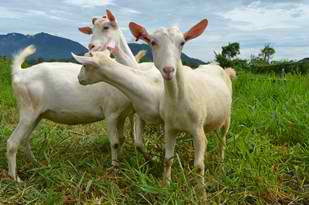At the moment, there is a very small dairy goat inventory, which is barely 6,379 head or 0.17% of the total goat population. Of this meager herd, only about 600 head are in the milk line, 70% of which are suspected to be harboring subclinical mastitis. As a result, the production of quality milk decreases. Backyard milk production stands at 0.5li/day with commercial farms producing barely a little over 1li/day. Lactation length is also compromised at 90 days for the backyard farms and 180 days for most commercial farms.

Saanen goats at the Alaminos Goat Farm in Laguna (Photo from the Livestock Research Division, DOST-PCAARRD)
At the moment, very little R&D has been done on dairy goat. The limited R&D in various institutions is also fragmented. Because of these, interventions to improve productivity of the current genotypes in the country such as Saanen and Anglo Nubian are compromised.
Despite these problems, the potentials of goat milk are very bright. Milk from dairy goat is known as the healthier alternative to cow’s milk, as it has smaller, well-emulsified fat globules, without agglutinin protein hence, promoting easier digestion and assimilation in the human body. This makes dairy goat milk very appropriate for children and old people alike.
Dairy goat’s milk also lacks the alpha-s1-casein protein, thus producing no allergic reactions unlike cow’s milk. It has significant proportion of medium chain triglycerides, recognized as highly beneficial to a number of health issues, and has higher amounts of vitamins and minerals with greater bioavailability.
Milk from dairy goat is also good as skin exfoliant and moisturizer. In the countryside where meat consumption is low, goat milk is an important daily source of protein, phosphate and calcium not otherwise available because of lack of cow’s milk.
Goat dairying is also more financially rewarding for the smallhold than cattle and carabao dairying, as income is relatively higher. All these advantages make goat production and goat dairying nowadays popular, propelling farmers to venture into such business and for the Philippine Council for Agriculture, Aquatic and Natural Resources Research and Development of the Department of Science and Technology (DOST-PCAARRD) to pour in investments to address the gaps in goat research and development (R&D).
Dairy Goat ISP accomplishments
The National Dairy Goat S&T Program is being implemented to spur the development of the local dairy industry by increasing local milk production from healthy dairy goats by 150% in 2017. This is from a 58% increase in dairy goat herd (6,380 to 10,084 head), 37% reduction in subclinical mastitis (70 to 44%), and 60% increase in does in the milk line (from 600 to 960 head). Productivity is expected to increase with the various S&T initiatives on breeding, feeding and health.
As of December 2015, the program has completed the profiling and characterization of the management practices of each of the participating dairy goat farms vis-à-vis their production performance. These data will determine the best performing dairy breeds suited to the country that will be promoted to farmers.
To give smallholders access to the best genetic materials from the good breeds and eventually ensure dairy goat herd build-up, breeding methods such as artificial insemination (AI) and natural breeding will be introduced in the countryside. In preparation for this, the Program has initiated in 2015 the enhancement of AI laboratories at the Isabela State University (ISU) and Department of Agriculture Region 8 (DA-RFO8). The nucleus farm at ISU was enhanced with breeders that will be used for semen collection and buck loan program.
Five researchers were trained in Australia on herd recording, semen processing, and embryo transfer. One hundred twenty-one AI service providers were also trained to help rollout the AI technology for dairy goat in Regions 2, 3, 7, and 8.
To ensure that appropriate nutrition suited to the best performing breeds is developed, the Program will evaluate Indigofera zollingeriana as milk yield enhancer. In 2015, the Program has completed the agronomic characterization of the plant and started seedling production and the plant’s chemical analysis. The pelletized Indigofera-based diet for lactating does was formulated and feeding trial on its effect on milk yield is ongoing.
To realize the potential increase in milk yield, inefficiencies in the milking process must be reduced thru an effective mastitis control program. In 2015, the program started developing a portable diagnostic kit. Specifically, the Program assessed the local reagents to be used in detecting intramammary infections (IMI) in goats. A researcher was also trained at Langston University on diagnostic and management protocols for IMI in goats.
DOST-PCAARRD will showcase dairy goat including other science and technology (S&T) agri-aqua research and development (R&D) outputs on March 2, 2016 during the SIPAG FIESTA technology forum at its headquarters in Los Baños, Laguna.
SIPAG, a technology transfer strategy, embodies the Council’s commitment to DOST’s Outcome One in a bid to ensure that the fruits of R&D activities for the agri-aqua sectors will be a blessing for every Juan.
The SIPAG FIESTA event will be held from March 2-4, 2016.
by Livestock Research Division, DOST-PCAARRD S&T Media Service
